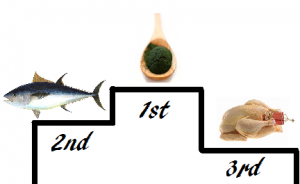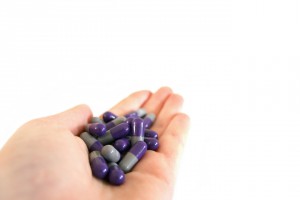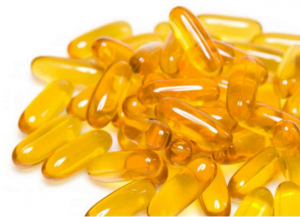Being the most nutrient dense natural food on the planet, you wonder what is in spirulina? Well put on your reading glasses because this is going to be quite a list.
Lets begin with the proteins that are part of spirulina
If you were to look at the structure of spirulina you would see a large amount of ribosomes, which actually manufacture the proteins. These ribosomes make spirulina the most protein rich food there is. Higher than any other food!, varying between 60-70% protein. That is over twice the protein content of beef!
And the protein spirulina provides is “complete”, containing all 8 essential amino acids
These include phenylalanine, valine, threonine, tryptophan, methionine, leucine, isoleucine, and lysine. The fact that spirulina contains all of these is important. Your body is not able to manufacture the essential amino acids so they have to be supplied through diet.
Besides the essential amino acids, it also has 10 of the 12 non-essential amino acids. Non-essential amino acids are ones that don’t HAVE to be provided from foods. Your body is able to synthesize them if it has to (if the proper nutrients are available). However, it is better to provide them in your diet. Of this group, spirulina includes alanine, arginine, aspartic acid, cystine, glutamic acid, glycine, hystidine, proline, serine, and tyrosine.
Spirulina also contains a vast array of minerals, picked up from the waters it grows in
Depending on the environment spirulina is grown in it can absorb different minerals throughout its short lifetime. Due to the natural alkaline water that spirulina grows best in and has for thousands of years, it actually synthesizes some minerals and derivative compounds.
Spirulina turns minerals into natural and organic forms that are actually ABLE to be used by the body. Many minerals, when taken, do not provide any value because they aren’t usable. Minerals in spirulina are able to bond with the amino acids and are then able to be more easily used by the body.
Minerals that you can expect to get from spirulina include potassium, magnesium, zinc, calcium, manganese, selenium, iron, and phosphorus.
Moving on.. it provides vitamins that are essential for metabolic processes
Of the B vitamins, which help the body convert carbohydrates into energy (in the form of ATP), spirulina has vitamin B1, B2, B3, B5, B6, B7, B8, B9, and B12. Almost all of them! The B vitamins are often marketed for their energy boosting properties. But they offer more than just more energy. They are very important for growth, development, and many other functions.
Just to name a few.
Vitamin B2, riboflavin, is one of the vitamins that is most commonly deficient in people. It is important for eye health. If you are deficient you may experience watery eyes, cataracts, and failing vision.
Pantothenic acid, which is vitamin B5 is known as the “stress” vitamin for its rule in physical and mental stress response. During times of stress it, along with vitamin C and cholesterol, make cortisol and other steroids in the body.
Biotin, or vitamin B7 is great for your hair health. If you are a woman, chances are you have heard of biotin for accelerating hair growth. It may be necessary to consume biotin regularly because foods such as raw egg whites and certain fish destroy your body’s supply.
There is a lot of controversy around vitamin B12 in spirulina, with all too much false advertising going around. Spirulina does contain a large amount of this vitamin, but most of it (around 85%) is in a form that biologically inactive in the human body. It cannot be used and is absolutely worthless.
Besides the B vitamins spirulina also gives you some Vitamin E. Vitamin E, like the B vitamins, is often used for increased energy. It has properties that are beneficial to skin and hair too.
Spirulina has “carotenoids” too, these are precursors to vitamins
Carotenoids are not vitamins, but they provide your body with the nutrients so that your body is able to synthesize vitamins.
Spirulina has the carotenoids alpha-carotene, beta-carotene, xanthophylis, cryptoxanthin, echinenone, zeaxanthin, and lutein.
From cryptoxanthine and beta-carotene your body is able to make vitamin A. This is actually a safer and healthier way to get vitamin A than from sources where it has already been synthesized, such as liver.
Why is this? Because vitamin A is fat soluble and can get “stuck” in the body instead of being excreted when there is too much. So if you would ingest too much you may overdose. But when your body synthesizes its own vitamin A it only creates what it needs to, and doesn’t need to excrete any.
Next up, the fats…Yes spirulina has fats
However it is a very tiny amount (only 7% lipid!). And what it does have is mostly essential fatty acids, which are GOOD.
One of which is gamma linolenic acid (GLA). This fatty acid has a number of benefits. It is commonly used as a remedy for joint pain due to its anti-inflammatory properties. And for healthy skin. It gives skin more elasticity, decreases wrinkles, and just makes it overall healthier.
GLA is most commonly found in vegetable oils and poultry foods. Spirulina is a much healthier choice than any other for this particular nutrient.
Other fatty acids it has include linoleic, linolenic, and arachidonic acid, which make up vitamin F. These acids are considered “essential” fatty acids and are exactly that. They are critical in oxygen transport for cell respiration and for controlling cholesterol in the blood. Other benefits to these fatty acids are healthier hair, skin, and nails.
And carbs too!
Just like the fats, spirulina has a very low amount of carbohydrates, accounting for only about 20% of its weight.
What carbs it does have are mostly in the form of glycogen. Meats and fish are the only other known sources of glycogen that you can obtain through food. No vegetables contain this, making your body synthesize its own glycogen from the provided carbs. But spirulina has it made and ready for your body to put it to use. It is stored in the muscles and acts as “quick” energy when needed.
If you are worried about the amount of sodium, DON’T
This is one great thing about spirulina compared to other seaweed type foods. Foods like nori and wakami are high in sodium, making it important to limit your consumption.
With spirulina you don’t have to worry. In one serving, which is commonly 7g, of spirulina you only get about 73mg of sodium. This is not even dangerous for someone on a salt-restricted diet.
Do you have any questions about the content of spirulina??? Or just maybe a comment? Be sure to leave them below and I will get back to you 🙂

I love the clarity you give on B12 in spirulina. There is a lot of false information out there about ways to get B12 from non-animal products. I always see spirulina as a option to add to smoothies at restaurants, but I never knew exactly what it was. This post is very informational. Spirulina is an algae, right? Do you know where the best source of spirulina is? So many waters are contaminated nowadays, so I always like to know exactly where my food comes from if you know what I mean. Do you know if spirulina contains any iodine? I eat seaweed for its many health benefits, including its high, pure iodine content. I like to have a good variety in my diet, so spirulina might be a good addition!
Yep, spirulina is considered an algae. But its not a plant type algae, its actually a bacteria.
I have listed some of the best spirulina products which I have reviewed (Click Here to View Them). These spirulina products are all grown in quality conditions with quality assurance measures in place.
Spirulina does contain iodine at about 15mcg per 3g spirulina. The RDA for iddine is 150mcg if you are over 19 years old.